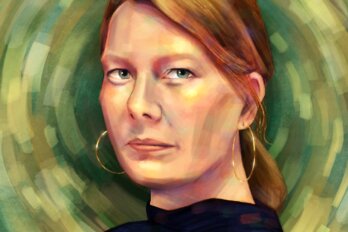There is much that tea can tell us. Some estimates suggest the earliest physical evidence of tea dates back to around 1000 BCE, to the Song Dynasty in China, and that early teas existed for a variety of reasons, including consumption, as a unit of trade, and as a religious offering. The Camellia sinensis plant was domesticated, and its delicate leaves were dried and then soaked in hot water. Today, there are more than twelve species of Camellia and thousands of subtypes, and we enjoy easy access to innumerable flavours and blends.
There has always been a kind of magic to tea: in Victorian England, it became popular to use the patterns of loose tea leaves in a cup to read the future. And, while people around the world enjoy the simple combination of boiled water and flavourful leaves (among countless permutations), tea rituals elevate the process to an art form.
It’s that magic, that art, that captivated Judy I. Lin as a writer. Tea was omnipresent throughout her childhood in Kaohsiung City, Taiwan, but it was only as an adult that she learned her family practised an ancient ceremony to brew it: gongfu cha, or “tea prepared with skill.” The ritual can involve careful management of everything from the ingredients selected to the temperature of water and brewing times. Even teapots are sometimes chosen thoughtfully to maximize quality. In 1995, when Lin was eight, her family immigrated to Calgary, where she lives now, in search of new opportunities and better education for her. Though she’d learned some English in Taiwan, she had a heavy accent, and life in a new country was difficult, she recalls. To process her experiences and feelings, she began to write. Stories have always been at the centre of her life: the books she devoured—her favourites were fantasies, including the Darkangel trilogy by Meredith Ann Pierce and the Night World series by L. J. Smith—and the Taiwanese folklore and mythology that underpinned her childhood. “It’s easier for me to communicate through words,” Lin says, “rather than speaking.”
She wrote stories off and on through her teenage years and dipped her toes into poetry in high school and at the University of Alberta, where she studied cell biology. She earned a master’s in occupational therapy from the same institution and worked for years in the medical industry. With a stable career, she returned to writing, initially creating fanfiction based on video games. “It was really fun to create in an already established world,” she says.
In 2016, she entered Pitch Wars, an annual online competition that paired aspiring writers with mentors and gave them a chance to pitch manuscripts to industry professionals. Her contemporary young adult horror novel landed her an agent but not a book deal. Disappointed but undeterred, she began outlining a YA fantasy novel that drew on histories and mythologies she had grown up with and that was centred on the one constant in her life: tea. Tea became not only the primary plot device but also the source of magic in A Magic Steeped in Poison, Lin’s debut that was published in March. The novel immediately reached #1 on the New York Times Best Sellers list in the “Young Adult Hardcover” category and remained on the list for four weeks. It proved to be a breakaway success that speaks both to Lin’s creative take on a genre and to a changing industry that is finally beginning to be more representative of the readers who consume that genre.
For decades, fantasy books—both adult and YA—have largely told stories dominated by themes and settings of an imagined Anglo-Saxon Europe. The genre rarely strayed beyond the ideas of a handful of cultures and was dominated by white men. In recent years, however, readers of science fiction and fantasy have pushed for better representation of diverse writers. Recent successes have transported readers to worlds inspired by everything from 1970s’ Asia in the Green Bone Saga by Fonda Lee to the pre-Columbian Americas in the Between Earth and Sky series by Rebecca Roanhorse to West Africa in the Deathless series by Namina Forna.
Lin’s research is evident through A Magic Steeped in Poison. The novel brims with references to Taiwanese and Chinese mythology. Foremost among these is Shennong, a mythological Chinese emperor who may have ruled around 2000 BCE and whom folklore credits with introducing various agricultural inventions. While many allusions, both historical and mythological, to Taiwan and China have been tweaked to fit her imaginary world, she hopes readers will recognize the nods.
When Lin began constructing her novel, though, she was worried about this particular aspect of world building. “Obviously, I haven’t lived in Taiwan for many years, and it just seemed really daunting: having to do something that was historically based. And how much history did I want to put in there?” she says. “I think that’s something that a lot of diaspora writers struggle with. Just whether we are able to write that kind of story, if it will be received well.”
In traditional publishing, most works of fiction, particularly debuts, are purchased by publishing houses as complete manuscripts. But Lin’s proposal—which only included an outline, themes, and sample pages—was impossible to ignore for Emily Settle, an editor at Feiwel & Friends, an imprint of Macmillan Children’s Publishing Group. “Judy’s writing came through immediately,” Settle says. “The first line—this never happens—the first lines of her proposal chapters stayed the first lines of the book.”
“I used to look at my hands with pride,” reads a sentence from the opening paragraphs of A Magic Steeped in Poison. “Now, all I can think is, ‘These are the hands that buried my mother.’” It’s sharp, emotional writing like this that underpins Lin’s style, one which keeps her epic fantasy rooted in what matters most in any novel: character. The book follows the story of Ning, a young girl from a rural area, living far from the politics and machinations of the capital, who is caught in a quest to save her family and to find the answers to the mystery of her mother’s death by poison. She finds herself with no choice but to travel to the capital to participate in a competition to select the next court shénnóng-shī, the magical tea practitioners in Lin’s world. She hopes that, if she wins, she can secure the resources to save her sister, who has also been poisoned. Lin intentionally planned a book that played on familiar YA fantasy structures: the villager cast into a wider world, the underdog in a high-stakes competition. But the book is elevated both by the richly detailed settings and the compelling tapestry of layered characters caught up in world-shaking events far beyond the scope of Ning’s quest or of the competition.
What stands out most, though, is Lin’s inventive system of magic. The fantasy genre, both in its adult and YA iterations, is full of structures invented by authors to explain their characters’ impossible feats: wizards harness complex spells, assassins cloak themselves in supernatural shadows, and necromancers command undead revenants. Often, these are the trusses that underpin the genre’s epic scope. Instead of following such systems, Lin takes the simple cup of tea—the production, the product, the ceremony—and ingeniously makes it the heart and source of her world’s magic. “I wanted to do something—I wouldn’t say quieter, because I think it’s just a different type of intensity,” Lin says. “Something more mental and something that is related to empathy and a little bit of puzzle solving.” Magical tea practitioners, in Lin’s world, can use their craft to heal, to enhance physical abilities, to tell the future, and for a host of subtler expressions of magic. Lin’s idea stands out, even in a genre marked by many creative twists on magical systems, and perhaps helps explain the book’s bestseller status.
Many aspects of the intrigue in Lin’s complex, Song Dynasty–inspired court are drawn from another wildly popular medium: Chinese television dramas. Lin has been an avid watcher of “C-dramas,” as they’re known, for years, and she has always been gripped by that world—one with beautiful settings and people who are moved like chess pieces. Her favourite, known in English as Nirvana in Fire, played an especially key role in constructing the court in A Magic Steeped in Poison—one that Ning is thrust into as an outsider and forced to navigate carefully.
The book ends on a cliffhanger—something that always runs the risk of annoying readers who might have to wait years for the sequel. Instead, Settle and the publishing house decided on an aggressive schedule: part two of Lin’s duology, A Venom Dark and Sweet, was published in August, just months after her March debut. (It debuted at #3 on the New York Times Best Sellers list.) The tactic is not unheard of but is far from the norm in an industry that has largely followed a one-book-a-year model for individual authors for decades. It’s also the first instance of such a release schedule for a debut that Settle is aware of. But, in an era of Netflix and binge watching, Lin’s duology is designed to be devoured. “There’s just so much content out there,” Settle says. “So it’s trying to stand out in such a way and making it a better reading experience. I think there’s something to be said for having both books available and being able to finish the story.” The move also speaks to the confidence Settle had in Lin. And, though it remains to be seen whether this trend will catch on, Settle thinks other publishers may follow suit.
There is a certain alchemy to the perfect cup of tea: temperature, flavour, and scent come together at the right place and time—and, when they do, it can be transcendent. There’s a similar magic to the best books—a coming together of disparate elements in sometimes unpredictable ways to create a sensory whole. But that magic can be fleeting, and the publishing world can be as arcane and complex as any system of magic. If you’re bold, though, and willing to try new things and new ingredients, sometimes all those elements coalesce into a story that will stand the test of time. Lin’s duology was never afraid of taking risks—from an ambitious, creative pair of books sold on proposal by a debut author to an aggressive publishing schedule. It might not have worked out. But the various aspects of her world are, ultimately, that same sort of alchemy. And the result is magic.






